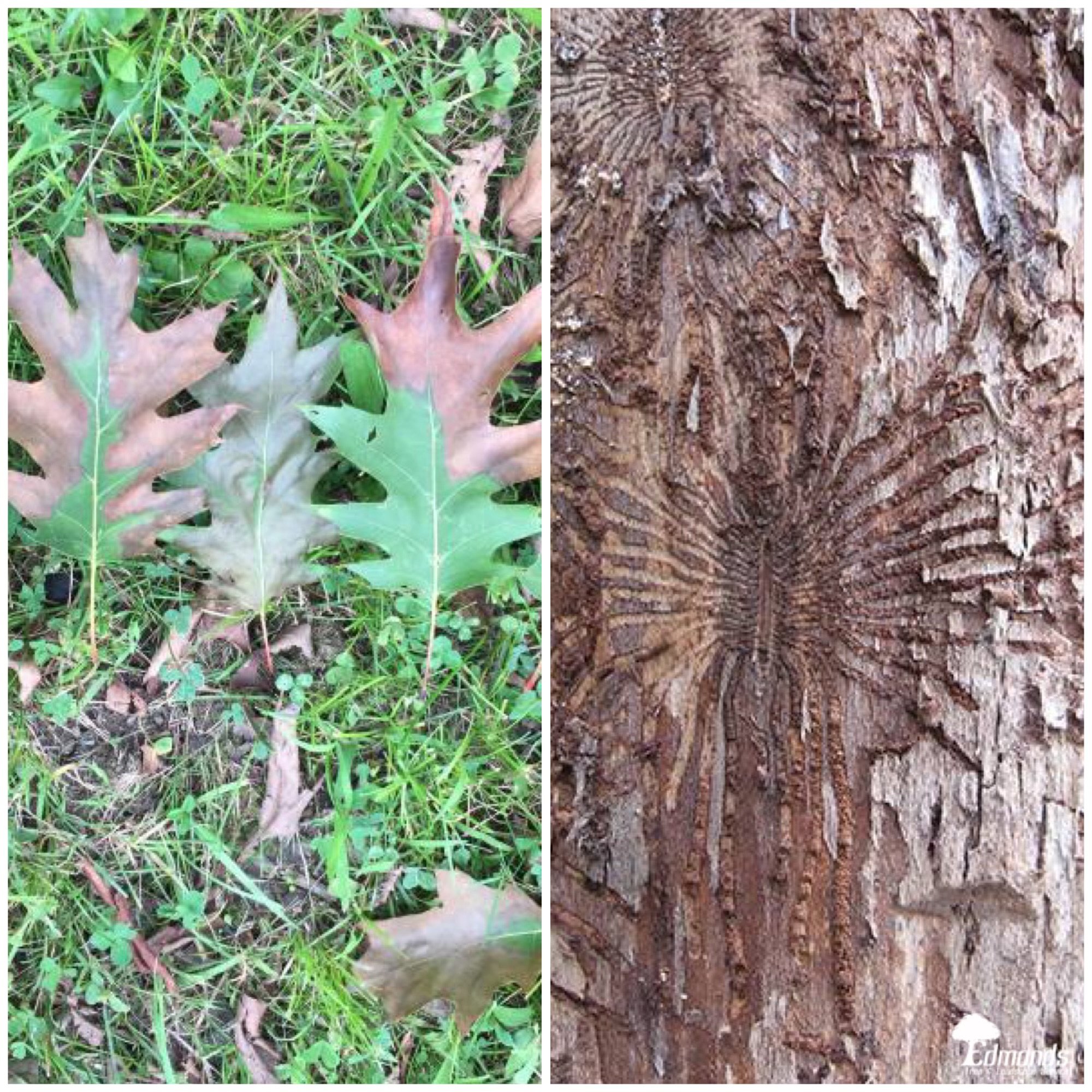Tree Disease Alert: Protect Your Landscape from Oak Wilt & Dutch Elm Disease
To the left: Pin Oak leaves showing symptoms of Oak Wilt, we need to test to confirm Oak Wilt.
To the right: An American Elm with bark beetle galleries, the beetles boring did not cause the mortality of the tree, but they were responsible for carrying the disease.
At Edmonds Tree & Landscape Service, we understand the devastating impact that tree diseases can have on your landscape. Two of the most serious threats to trees in Central Ohio are Oak Wilt and Dutch Elm Disease. Early detection and professional management are crucial to protecting your trees and preventing these diseases from spreading. Learn more about these diseases below and how we can help safeguard your trees.
What is Oak Wilt?
Oak Wilt is a destructive fungal disease caused by Bretziella fagacearum, primarily affecting oak trees in the red oak group (e.g., Northern Red Oak, Pin Oak, Black Oak). It spreads rapidly and can kill a tree within weeks of infection.
How Does Oak Wilt Spread?
• Root Grafts: The disease spreads underground through interconnected roots between nearby oak trees.
• Sap-Feeding Beetles: These beetles carry fungal spores from infected trees to fresh wounds on healthy oaks, especially during the warmer months.
Signs of Oak Wilt Infection
• Leaf Symptoms: Leaves wilt and turn brown from the edges inward, often falling off the tree prematurely—sometimes as early as spring or summer.
• Rapid Decline: Red oaks can die within weeks of showing symptoms, while white oaks are more resistant but may decline over several seasons.
Preventative Measures for Oak Wilt
• Avoid Pruning in Warm Months: Avoid pruning or wounding oak trees between April and mid-October, as this is when beetles are most active.
• Seal Tree Wounds: If pruning is necessary during beetle season, use wound dressing to seal cuts and minimize the chance of infection.
• Fungicide Injections: Preventative fungicide injections may protect valuable oaks, but this must be done by a certified arborist.
How We Manage Infected Trees
• Immediate Removal: Infected trees should be removed as soon as possible to prevent the disease from spreading, especially to nearby oaks.
• Root Barriers: We can sever root connections between infected and healthy trees to stop the underground spread.
What is Dutch Elm Disease?
Dutch Elm Disease (DED) is a fungal disease caused by Ophiostoma novo-ulmi or Ophiostoma ulmi, primarily affecting American elms. This disease has wiped out millions of elm trees across the country and continues to be a threat in Central Ohio.
How Does Dutch Elm Disease Spread?
• Elm Bark Beetles: Beetles that feed on elm bark carry fungal spores from infected trees to healthy ones, spreading the disease.
• Root Grafts: In urban environments, the disease often spreads through interconnected roots between neighboring elm trees.
Signs of Dutch Elm Disease Infection
• Leaf Wilt: One of the earliest signs is wilting and yellowing of leaves, usually starting in the upper crown and moving downward.
• Branch Death: Infected branches die off, and without intervention, the disease can spread through the entire tree within a single season.
• Sapwood Staining: Removing bark may reveal brown streaks in the sapwood, indicating infection.
Preventative Measures for Dutch Elm Disease
• Avoid Pruning During Beetle Season: Elms should not be pruned between April and mid-October to reduce the risk of infection.
• Remove Infected Wood: Infected or dead trees must be promptly removed and properly disposed of (by burning, burying, or chipping) to prevent further beetle transmission.
• Fungicide Treatments: Preventative fungicide injections may protect high-value elms, but this is a measure best performed by professional arborists.
How We Manage Infected Elms
• Quick Removal: Infected trees are often beyond saving and should be removed immediately to protect surrounding healthy trees.
• Sanitation Practices: Proper disposal of infected wood is essential, as elm bark beetles can continue to spread the disease from the woodpile.
Why Choose Edmonds Tree & Landscape Service?
With over 60 years of combined experience, our team of ISA Certified Arborists® is committed to the health and longevity of your trees. We specialize in diagnosing and managing tree diseases like Oak Wilt and Dutch Elm Disease, helping protect your landscape and the urban forest in Central Ohio.
Our Tree Disease Services Include:
• Disease diagnosis and consultation
• Preventative pruning and treatments
• Safe removal of infected trees
• Root barrier installation
• Ongoing monitoring and care

